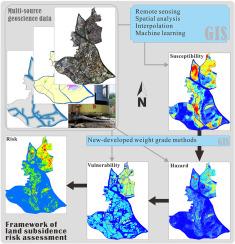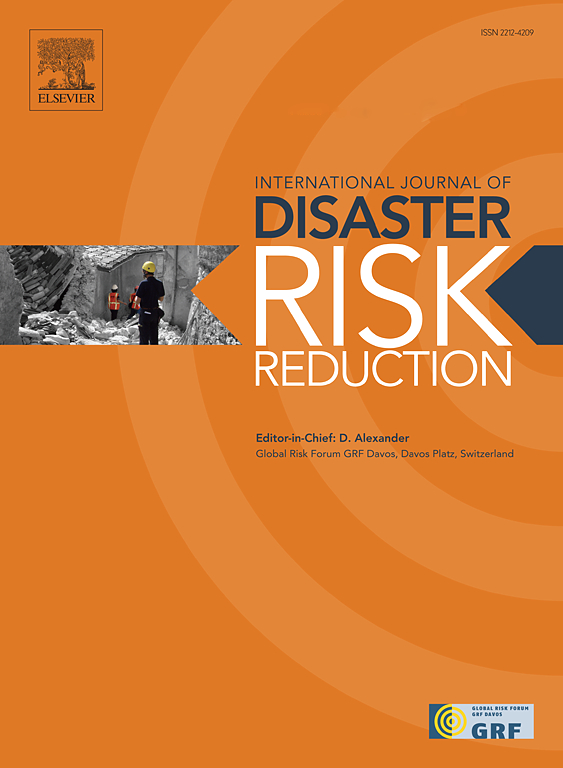Multisource geoscience data-driven framework for subsidence risk assessment in urban area
IF 4.2
1区 地球科学
Q1 GEOSCIENCES, MULTIDISCIPLINARY
International journal of disaster risk reduction
Pub Date : 2024-10-15
DOI:10.1016/j.ijdrr.2024.104901
引用次数: 0
Abstract
Land subsidence, especially in developed cities, poses significant risks to human life, social property, and urban sustainability. Taking Liwan District in southern China as an example, this study proposed an acceptable framework for regional land subsidence risk assessment while complying with current national assessment system. With integrating the multi-source geospatial data from remote sensing and various geology surveys into ArcGIS, the subsidence risk assessment was carried out based on the subsidence susceptibility mapping, hazard and vulnerability surveying by using a series of data-driven methods. The results showed that, (i) although not all surface deformations detected by InSAR technology were caused by subsidence, they were instrumental in updating subsidence records; (ii) with the help of spatial correlation analysis using weight evidence as well as multi-source data fusion in high spatial resolution, the Random Forest-based classification models effectively identified the land use types and accurately mapped the land subsidence susceptibility; (iii) the hazard and vulnerability surveying based on a series of newly developed combined weight methods, improved the reliability of risk assessment; (iv) the extremely high- and high-risk areas from the zoning of the land subsidence, provided target areas for further management and prevention of land subsidence. This comprehensive and quantitative assessment framework highlights the need for continued monitoring in subsidence-prone regions, helping to propose strategies for risk mitigation and adaptive planning in urban areas.

多源地球科学数据驱动的城市地区沉降风险评估框架
土地沉降,尤其是发达城市的土地沉降,对人类生命、社会财产和城市可持续发展构成重大风险。本研究以华南地区荔湾区为例,在符合国家现行评估体系的前提下,提出了可接受的区域土地沉陷风险评估框架。通过将遥感和各种地质调查的多源地理空间数据集成到 ArcGIS 中,利用一系列数据驱动方法,在沉陷易感性绘图、危险性和脆弱性调查的基础上开展了沉陷风险评估。结果表明:(i) 尽管 InSAR 技术探测到的地表变形并非都是由沉降引起的,但它们有助于更新沉降记录;(ii) 借助权重证据的空间关联分析以及高空间分辨率的多源数据融合,基于随机森林的分类模型有效识别了土地利用类型,并准确绘制了土地沉降易感性图;(iii)基于一系列新开发的组合权重方法的危险性和脆弱性调查,提高了风险评估的可靠性;(iv)从土地塌陷区划中划分出的极高风险区和高风险区,为进一步管理和预防土地塌陷提供了目标区域。这一全面的定量评估框架凸显了对地表沉降易发区域进行持续监测的必要性,有助于提出城市地区风险缓解和适应性规划的策略。
本文章由计算机程序翻译,如有差异,请以英文原文为准。
求助全文
约1分钟内获得全文
求助全文
来源期刊

International journal of disaster risk reduction
GEOSCIENCES, MULTIDISCIPLINARYMETEOROLOGY-METEOROLOGY & ATMOSPHERIC SCIENCES
CiteScore
8.70
自引率
18.00%
发文量
688
审稿时长
79 days
期刊介绍:
The International Journal of Disaster Risk Reduction (IJDRR) is the journal for researchers, policymakers and practitioners across diverse disciplines: earth sciences and their implications; environmental sciences; engineering; urban studies; geography; and the social sciences. IJDRR publishes fundamental and applied research, critical reviews, policy papers and case studies with a particular focus on multi-disciplinary research that aims to reduce the impact of natural, technological, social and intentional disasters. IJDRR stimulates exchange of ideas and knowledge transfer on disaster research, mitigation, adaptation, prevention and risk reduction at all geographical scales: local, national and international.
Key topics:-
-multifaceted disaster and cascading disasters
-the development of disaster risk reduction strategies and techniques
-discussion and development of effective warning and educational systems for risk management at all levels
-disasters associated with climate change
-vulnerability analysis and vulnerability trends
-emerging risks
-resilience against disasters.
The journal particularly encourages papers that approach risk from a multi-disciplinary perspective.
 求助内容:
求助内容: 应助结果提醒方式:
应助结果提醒方式:


